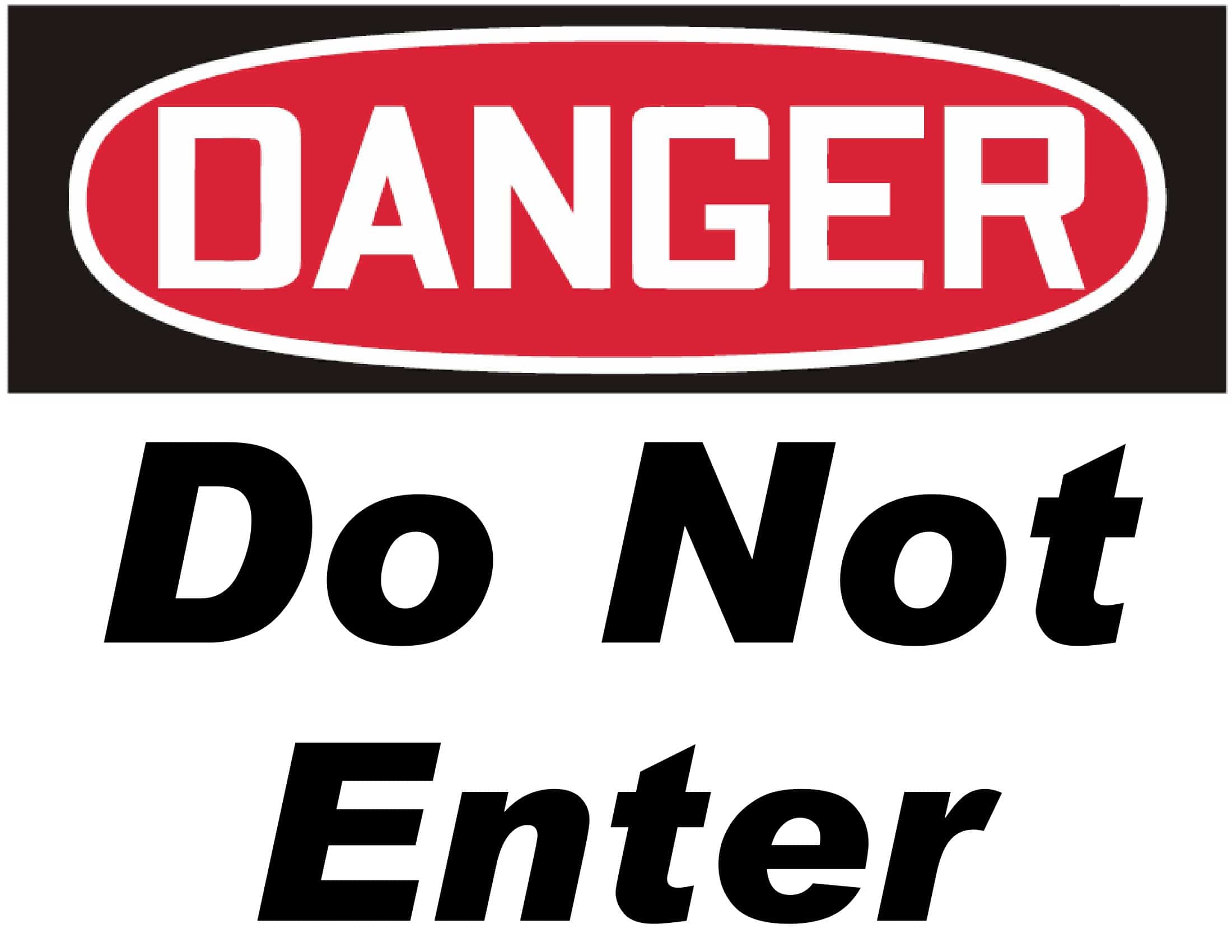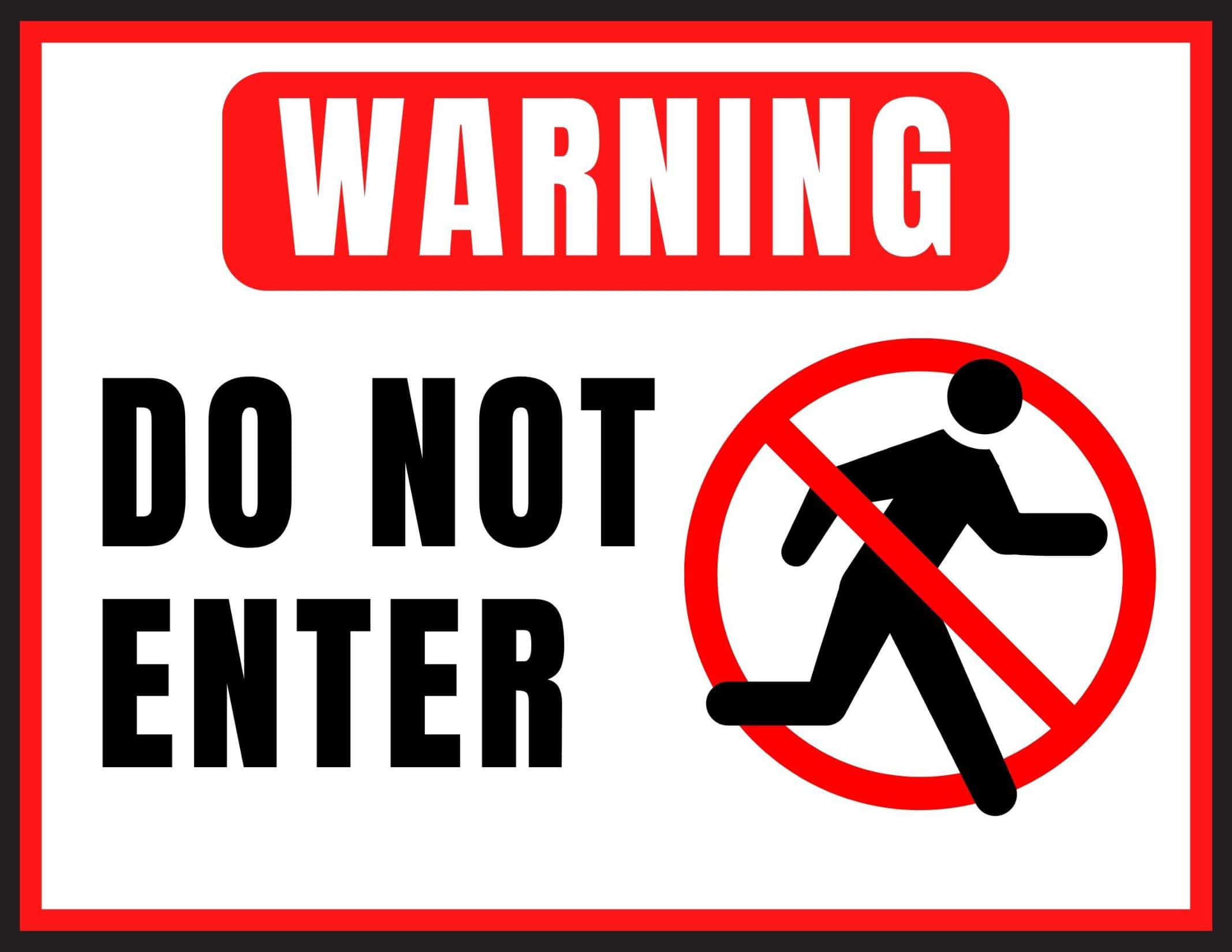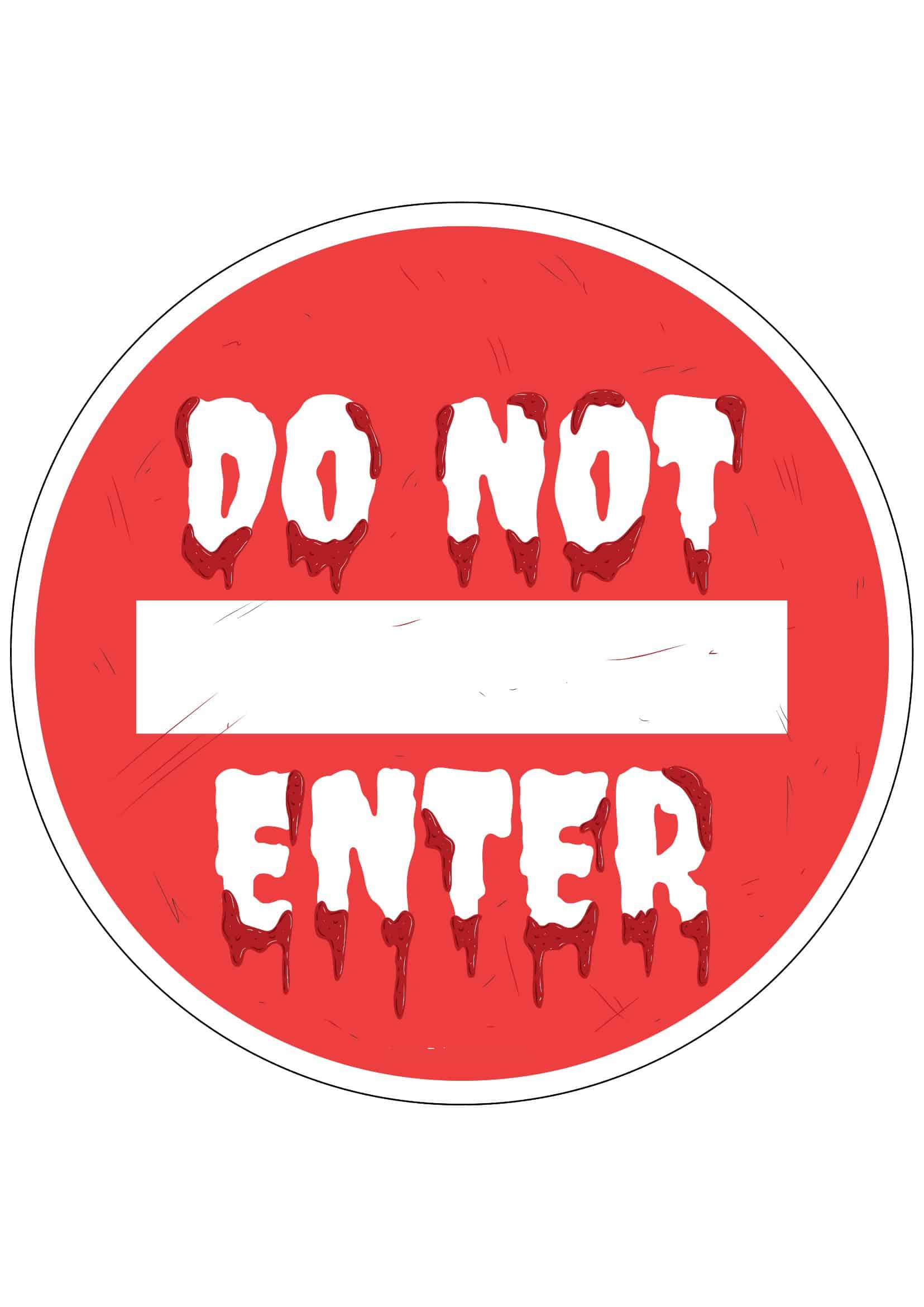Effective facility management relies on adequate signage directing traffic flow and access. While do not enter signs can be purchased, quality customizable options get expensive, especially when signs get damaged or rules change. This article provides free printable DIY templates for creating versatile do not enter signs when and where needed. Our professional designs allow easy editing with concise restrictions, applicable dates, and custom icons.
Printed on weatherproof materials like plastic, metal, or heavy cardstock, these signs withstand indoor/outdoor use. Prominent posting at restricted access points, on doors/gates, or near hazards gives advance notice and reinforces rules. For building managers seeking affordable options to promptly replace worn signs or generate new notices, these templates are a budget-friendly solution. Follow our guide for ideal sign placement based on fire codes and ADA standards. Quickly produce eye-catching do not enter signage on demand using our high quality printable templates.
Table of Contents
Do Not Enter Sign Templates
A do not enter sign prohibits access into a restricted area or direction of travel. It communicates that entry is not permitted. A do not enter sign template provides a standardized design.
The sign features a white slash overlaid on a red circle to convey the restriction. Bold text such as “DO NOT ENTER” or “WRONG WAY” reinforce the message. High contrast colors and graphics maximize visibility. The versatile template can be posted indoors or outdoors.
Strategically placing clear do not enter signage prevents accidental entry into unauthorized areas. The familiar template and graphics quickly signal that passage is prohibited without needing to read text. Standardized symbols transcend language barriers. A recognizable template helps reinforce safety and regulatory compliance.
The Origins of Do Not Enter Signs

Brief History and Evolution:
The “Do Not Enter” sign, widely recognizable by its bold text and universally understood implications, has a history that traces its roots back to the early days of road safety and industrial regulation. The original concept of the sign emerged as roadways became increasingly complex, and the necessity for clearer traffic guidelines became apparent. Before standardized signage, a hodgepodge of different symbols and terms were used, leading to confusion and, subsequently, accidents. However, with the advent of automobile associations and later, the establishment of governmental transport departments, standardized signs started to take shape. The “Do Not Enter” sign as we know it today became a part of the Manual on Uniform Traffic Control Devices (MUTCD) in the United States, a set of guidelines established to create uniform road signage and markings. This standardization allowed for the sign’s widespread adoption and recognition, making it one of the most universally understood signs in the world.
Different Applications Across Industries and Sectors:
While the “Do Not Enter” sign is perhaps most commonly associated with road traffic, its application extends across a broad range of industries and sectors. Here’s a look at some of the diverse contexts where this sign plays a crucial role:
- Traffic Control: Of course, the most widespread usage remains in road traffic management, where the sign indicates one-way streets or roads that are closed to public access.
- Industrial Settings: In manufacturing plants and industrial facilities, “Do Not Enter” signs may be used to designate areas that are unsafe or restricted, often to comply with Occupational Safety and Health Administration (OSHA) guidelines.
- Healthcare: In hospitals and healthcare centers, these signs are crucial for designating areas that are off-limits to unauthorized personnel, like operating rooms or quarantine zones.
- Private Property: Homeowners and private businesses also use “Do Not Enter” signs to deter trespassing and establish property boundaries.
- Retail and Public Spaces: These signs may be used to manage the flow of people and prevent entry into staff-only or restricted areas.
- Educational Institutions: Schools and colleges use “Do Not Enter” signs for labs, faculty rooms, and other areas where student access is restricted.
- Airports and Transit Hubs: To manage large crowds and ensure security, “Do Not Enter” signs are frequently employed to indicate restricted zones.
Types of Do Not Enter Signs
“Do Not Enter” signs serve as crucial traffic control devices, designed to enhance safety on roads and within various kinds of premises. These signs generally indicate that a driver should not proceed in the direction in which the sign is facing. The purpose is to avert any potential hazards or violations. However, there are different types of “Do Not Enter” signs used in various contexts, each with its specific nuances. Here are some:
Roadway “Do Not Enter” Signs
- Standard “Do Not Enter” Sign: This is the most common type seen on roads. It consists of a white rectangle with a red circle and a white rectangle running diagonally from the upper-left corner to the bottom-right corner. The sign simply indicates that the road ahead is off-limits for vehicles in the current direction.
- Wrong Way: Sometimes accompanying or replacing the standard “Do Not Enter” sign, the “Wrong Way” sign indicates that a vehicle is heading in a direction opposite to legal traffic flow. This is usually seen at highway off-ramps or one-way streets.
- Regulatory Combo Signs: Some “Do Not Enter” signs have additional plaques or panels below them, indicating specific rules like time restrictions or types of vehicles that are exempt from the rule.
Construction and Industrial Zones
- Construction “Do Not Enter” Signs: These signs are used in construction zones to prevent unauthorized entry. They might include extra information, such as “Authorized Personnel Only” or “Hard Hat Area.”
- Chemical and Biohazard Areas: These may display the “Do Not Enter” symbol along with symbols indicating chemical, biological, or radioactive hazards.
Private Property
- Private Property Signs: In residential or commercial areas, “Do Not Enter” signs may indicate private property, sometimes specifying “Residents Only” or “No Trespassing.”
- Restricted Access Areas: Within establishments like schools or hospitals, these signs may be used to prevent the general public from entering certain zones, like “Staff Only” areas.
Public Transport and Parking
- Transit Stops and Platforms: In some public transit stations, “Do Not Enter” signs prevent people from entering areas reserved for employees or emergency personnel.
- Parking Facilities: These signs may be used to indicate that a certain level or area of a parking facility is closed or restricted to certain types of vehicles.
Recreational and Protected Areas
- Parks and Beaches: Some recreational areas may have seasonal “Do Not Enter” signs, often due to wildlife nesting or dangerous conditions like high surf or avalanches.
- Trailheads: For hiking or off-road biking, certain trails may be marked as “Do Not Enter” due to maintenance, wildlife activity, or other safety concerns.
Digital and Interactive Signs
- LED Do Not Enter Signs: These can be activated or deactivated as needed and may be used in variable traffic scenarios, like reversible lanes or emergency situations.
- Automated Gates: These may feature “Do Not Enter” signs that activate when the gate is closed or when an unauthorized vehicle approaches.
Regulations and Guidelines
“Do Not Enter” signs are governed by a range of regulations and guidelines designed to ensure uniformity, recognition, and compliance. These regulations can vary depending on the jurisdiction and the specific application of the sign. Here’s an overview of the different kinds of regulations and guidelines that often apply to “Do Not Enter” signs:
Federal, State, or Country-Specific Standards
- United States: In the U.S., the Manual on Uniform Traffic Control Devices (MUTCD) serves as the national standard for all traffic control devices, including “Do Not Enter” signs. States may have their variations but generally adhere to MUTCD standards.
- European Union: The Vienna Convention on Road Signs and Signals serves a similar purpose in many European countries, though each nation may have its particular adaptations and additional regulations.
- Australia: The Australian Road Rules dictate what a “Do Not Enter” sign must look like and where it should be placed.
- Canada: The Manual of Uniform Traffic Control Devices for Canada (MUTCDC) is a guide used in Canada, similar to the MUTCD in the U.S.
Specialized Guidelines for Particular Industries
- Construction: The Occupational Safety and Health Administration (OSHA) in the United States or its equivalent in other countries may outline rules for “Do Not Enter” signs in construction zones, specifying features like the sign’s size, color, and text.
- Chemical and Biohazard: Entities like the Environmental Protection Agency (EPA) or the World Health Organization (WHO) may have specialized guidelines for signs indicating hazardous materials.
- Aviation and Maritime: Airports and seaports often have their own sets of rules for “Do Not Enter” signs, informed by federal and international guidelines.
- Healthcare: In hospital settings, guidelines from health departments or organizations like the World Health Organization (WHO) may apply.
Legal Implications of Non-Compliance
- Traffic Violations: Failure to obey a “Do Not Enter” sign on a road typically results in a traffic citation and a fine, the amount of which can vary by jurisdiction.
- Trespassing: On private property, ignoring a “Do Not Enter” sign can result in a trespassing charge, which can range from a misdemeanor to a felony depending on the circumstances.
- Occupational Hazards: Employers who fail to adequately signpost hazardous or restricted areas may be liable for injuries sustained due to this oversight. Penalties may include fines, legal action, and in severe cases, the closure of the business.
- Civil Liability: In some cases, failure to properly display “Do Not Enter” signs can result in civil lawsuits if someone is injured as a result.
- Criminal Charges: In extreme cases, such as unauthorized entry into high-security areas, ignoring a “Do Not Enter” sign could result in criminal charges.
- Revocation of Licenses: For businesses, non-compliance with signage regulations may result in the revocation of operational licenses or permits.
Free Printable Do Not Enter Signs Now Available on TypeCalendar
Ensuring the safety and organization of a space often requires clearly marked zones that are off-limits to unauthorized individuals. To facilitate this essential component of effective space management, TypeCalendar is excited to offer free printable “Do Not Enter” signs. Available in easily accessible PDF and Word formats, these signs are perfectly suited for both professional and personal use. Whether you need to restrict access to a construction site, a private office, or even a room in your home, our “Do Not Enter” signs are designed for clarity and universal understanding. Just download, print, and you’re good to go.
Funny “Do Not Enter” Signs on TypeCalendar
Who says safety can’t have a humorous side? For spaces that require restricted access but also have room for a touch of whimsy, we offer a special line of funny “Do Not Enter” signs. These signs blend functionality with humor, featuring amusing slogans or eye-catching illustrations. They’re perfect for light-hearted settings like game rooms, personal spaces, or casual workplaces where a regular “Do Not Enter” sign might feel too stern. Our funny “Do Not Enter” signs are also available in both PDF and Word formats, offering the same ease of download and customization as our more traditional designs.
Navigate Safely with TypeCalendar’s “Do Not Enter” Road Signs
Sometimes the need for a “Do Not Enter” sign extends beyond buildings and into roadways. Whether it’s a private road, a one-way street, or a temporarily closed route due to construction or an event, a clearly visible “Do Not Enter” sign is crucial for the safety of both drivers and pedestrians. TypeCalendar’s road-specific “Do Not Enter” signs are designed to meet standard road sign guidelines, making them instantly recognizable to motorists. Just as with our other signs, these are available for free download in both PDF and Word formats, ensuring maximum accessibility and ease of use.
Easily Download “Do Not Enter” Signs to Enhance Security
TypeCalendar understands that clear signage plays a pivotal role in ensuring the safety and security of any space. Our “Do Not Enter” signs are designed with this core principle in mind. The high-resolution signs are printable in various sizes without loss of quality, ensuring they are easily visible and understandable from a distance. The Word format offers the option for customization, allowing you to add specific information like hours during which entry is restricted or penalties for violations, thus making the signs adaptable to different settings and requirements.





















































![Free Printable Roommate Agreement Templates [Word, PDF] 1 Roommate Agreement](https://www.typecalendar.com/wp-content/uploads/2023/06/Roommate-Agreement-150x150.jpg)
![Free Printable Credit Card Authorization Form Templates [PDF, Word, Excel] 2 Credit Card Authorization Form](https://www.typecalendar.com/wp-content/uploads/2023/06/Credit-Card-Authorization-Form-150x150.jpg)
![Free Printable Stock Ledger Templates [Excel,PDF, Word] 3 Stock Ledger](https://www.typecalendar.com/wp-content/uploads/2023/08/Stock-Ledger-150x150.jpg)
